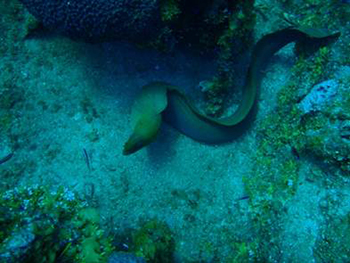Green Moray Eel
Gymnothorax funebris

Taxonomy
Kingdom Animalia
Phylum Chordata
Class Antinopterygii
Order Anguilliformes
Family Muraenidae
Description
The green moray eel is the largest of all the moray eels mass wise. It can get up to 3 meters (9.8ft) long and weigh as much as 36 kilograms (79 lb) (Moray). It appears to be a green color but actually has brown skin. This apparently green color comes from a yellow green mucus that covers its skin to help protect it from parasites and bacteria. The green color also acts as camouflage to help hide the eels from predators. The camouflage often extends in to the moray’s mouth. The moray eel has a row of very sharp rear-hooked teeth and opens and closes its mouth continually. It does this to keep water circulating over its gills (Green). Moray eels are the only animals that have a pharyngeal jaw that is used to catch prey (Moray)
Habitat
Green moray eels are benthic and live around shallow rocky shore lines, reefs, and mangroves (Green). They are found in tropical and temperate seas (Moray).
Behavior
The green moray eel is a nocturnal predator. During the day it hides in a hole in the rocks. It uses its sense of smell to find its prey because moray eels have very poor vision. It does not go hunting for its prey; instead it sits and waits for they prey to cross its path (Eels).
Reproductive cycle and family habits
Green moray eels live by themselves, and are very protective of their territory. But if not threatened they are normally calm and curious. The green moray’s breeding season is from July to September. The fertilized eggs float on top of the water until they hatch in to larvae called leptocephali. Leptocephali are transparent ribbon-like larvae. The larvae float around with the plankton for 8 months while they develop in to a young adult eel (Denver).
Diet
The green moray is a nocturnal hunter; it uses its sense of smell to hunt for fish, crustaceans such as crabs, and cephalopods such as squid. As observed with octopus, the green moray may eat its prey whole or piece by piece.
Ecology
Natives will eat moray eels, but they run the risk of getting ciguatera poisoning. The eels contract this poisoning by eating a type of plankton called dinoflagellates, or eating a fish that just ingested a lot of the dinoflagellates. If the dynoflagellates produce too much toxin the eels that eat them can be poisonous.
Emergency
Moray eels have very sharp rear hooked teeth. If you get bit by a moray eel do not try to pull your body part out. Once the eel bites down it cannot let go. You have to manually pry its mouth open even if it is dead. The best thing to do is kill it and then pry its mouth open (moray).
Research
There has not been a lot of research done on moray eels because of their occasional aggressiveness and weird habits, making them hard to catch (Reece, 2010). A handful of hospitals in Illinois studied the emergency management of moray eel bites. They examined and treated moray eel bites to people’s hands. All of the patients were given local wound care. One patient ended up with slight dysfunction of his hand but none of the patients developed a bacterial infection. The scientists took samples of both the mouths of morays that were caught after the bites and their surrounding water. They found that wounds could be successfully treated with aggressive antibiotics (Erickson, 1992.). There was also a study done to find out if there was a distinction between snake morays and true morays. They found that there was a taxonomic difference between the two (Reece, 2010).
Personal interest
I got to see some green moray eels on my trip to the Bahamas and thought that they were interesting animals. Shortly after I arrived back in the states, I saw a discovery channel show discussing the two jaws of the moray eels. I thought that this was cool and wanted to know more about them.
Literature Cited
"Eels, Saltwater Fish Aquarium - Aquatic Connection." Saltwater Reef Fish, Marine Fish, Reef Aquarium Coral, Saltwater Supplies & More - Aquatic Connection Live. Web. 26 May 2011. <http://www.aquacon.com/Eels_saltwaterfish.html>.
Erickson, T., T. Vandenhoek, A. Kuritza, and J. Leiken. "The Emergency Management of Moray Eel Bites." Annals of Emergency Medicine 21.2 (1992): 212-16. Print.
"Green Moray Eel." Denver Zoo. Denver Zoo. Web.< http://www.denverzoo.org/downloads/dzoo_moray_eel.pdf>.
"Green Morays, Gymnothorax Funebris at MarineBio.org." MarineBio.org - Marine Biology, Ocean Life Conservation, Sea Creatures, Biodiversity, Oceans Research... Web. 26 May 2011.< http://marinebio.org/species.asp?id=106>.
"Moray Eel." Wikipedia, the Free Encyclopedia. 28 Apr. 2011. Web. 26 May 2011.< http://en.wikipedia.org/wiki/Moray_eel#Taxonomy>.
Reece, Joshua S., Brian W. Bowen, David G. Smith, and Alan Larson. "Molecular Phylogenetics of Moray Eels (Muraenidae) Demonstrates Multiple Origins of a Shell-crushing Jaw (Gymnomuraena, Echidna) and Multiple Colonizations of the Atlantic Ocean, Molecular Phylogenetics and Evolution." Molecular Phylogenetics and Evolution 57.2 (2010): 829-35. Print.